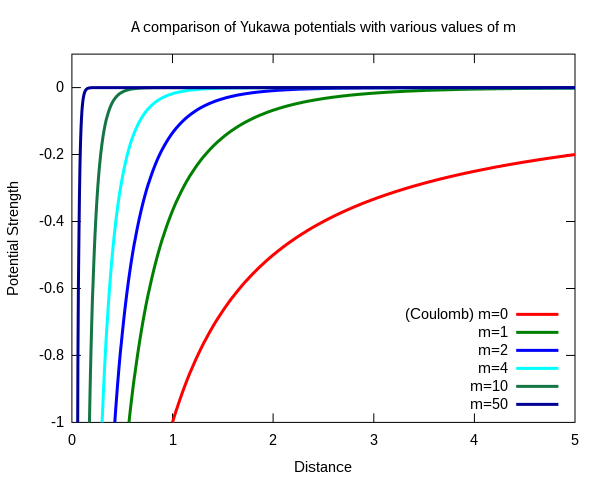"can be used to describe the nuclear force between nucleons (which are fermions), mediated by pions (which are pseudoscalar mesons). The Yukawa interaction is also used in the Standard Model to describe the coupling between the Higgs field and massless quark and lepton fields (i.e., the fundamental fermion particles). Through spontaneous symmetry breaking, these fermions acquire a mass proportional to the vacuum expectation value of the Higgs field." -(wikilink)
Thus, The Yukawa Potential and The Yukawa Interaction have to do with the force between protons in the nucleus of an atom. (Also, neutrons, since they are nucleons too).
This Yukawa potential has been used in particle physics to ""model"" how the strength of the force between the nucleons varies. This is a model of ""THE STRONG FORCE"", one of ""4 fundamental forces"".
This Yukawa potential has been used in particle physics to ""model"" how the strength of the force between the nucleons varies. This is a model of ""THE STRONG FORCE"", one of ""4 fundamental forces"".
Nassim Haramein: Singularities Black wHoles Atom, Proton, Gravitation
(Nassim explains here his approach to the Yukawa potential)
And, yes, those are Matt Foley ""double quotes""!!
""not the norm""
What I am here to tell you is the mainstream have used these ideas and estimations / approximations / derivations of various "Yukawa Potentials", and they are all different, all over the map, and scaled to fit a problem:
Figure 1: A comparison of Yukawa potentials where g=1 and with various values for m. (wikilink)
Anyway, if one simply models the relativistic effects
mass dilation using the Lorentz transform, a well known effect from Einstein's Special Relativity - it is the thing that says the speed of light is a constant for every observer and rate of time passage between relative observers slows down as the speed of light is approached, likewise, things shrink in the direction of moving, and the mass increases as one nears c. This is all part of special relativity,
one sees that the SAME ANSWERS, SAME SOLUTIONS are arrived at modeling the protons as spinning at (nearly) the speed of light around each other, and the mass increase and then the mass decrease after a collision to knock a proton (or neutron) from the nucleus. is modeled using the mass dilation of special relativity and it falls of very quickly and matches the time constant and resonance frequency of existing measurements as expected. (see PDF below).
So, what has Nassim explained in his same paper that he explains VERY accurately not only a solution to the proton radius problem, but also he explains the origin of mass, relates protons to black holes to the fabric of space time AND DERIVES a BETTER Yukawa potential than ANY of the ones in the rainbow chart above here.
Quantum Gravity and the Holographic Mass
Haramein, N. (2012). Quantum Gravity and the Holographic Mass, Physical Review & Research International, ISSN: 2231-1815, Page 270-292
 Download the PDF
Download the PDF
It's just not about physics, or simply a few solutions to the unsolved physics problems, it is a unified physics, as above, so below.
So, we are back down
to 2 (two)
fundamental forces:
gravity and electromagnetism.
The implications to these few fundamental things we have addressed successfully in this blog are more than enough to show that some very significant re-working and re-thinking of our mainstream science and physics and a whole lot more... ...is needed.
The Surfer, OM-IV


No comments:
Post a Comment
Watch the water = Lake 👩 🌊🦆